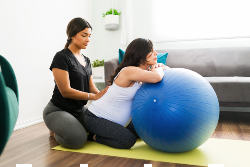Pregnancy or prenatal massage is a sure way to reduce the discomfort of pregnancy. It also helps minimize anxiety and improves mood. However, before getting this form of massage, you need to get your doctor’s go-ahead and understand everything it entails. Also, it’d be best if you worked with reputable therapists with prenatal massage training for safety measures.
Suppose you’re looking forward to having a prenatal or pregnancy massage. In that case, you might want to continue reading as this article will provide you with some in-depth information about what pregnancy massage is, what it involves, and much more.
1. What’s Pregnancy Massage?
Pregnancy or prenatal massage is a type that’s similar to a typical massage, aiming to relax muscles, improve blood circulation and mobility, ease sore spots, and make the body feel good. However, prenatal massage is customized depending on the requirements of a pregnant mom and the changes in their body. Prenatal massage is done by a professional therapist to ensure that they perform the activity accordingly.
Prenatal or pregnancy massage also helps reduce stress, relieve muscle and joint pain, and minimize swelling in the legs and arms in pregnant women.
2. Is Pregnancy Massage Safe?
When done by a trained therapist, pregnancy massage should be safe. Before choosing a therapist, ensure they’re trained and capable of doing a pregnancy massage. It’s also vital to have a mind-body massage from reputable clinics or centers for the safety of your pregnancy.
A pregnancy massage therapist should avoid putting pressure on certain points and be gentle on your tummy if they have to massage it. Also, electric blankets and heated beds should be avoided. You may also require assistance from your therapist when getting on and off the massage table.
You might also want to talk to your doctor before a pregnancy massage, especially if:
- You’re in the first trimester
- You have a high-risk pregnancy following high blood pressure or preeclampsia
- You experience morning sickness or vomiting
- You’re at high risk of miscarriage
- You experience swelling on your legs
- You experience bleeding or abdominal pain
3. What Does A Pregnancy Massage Entail?
Pregnancy can increase pressure on your back, neck, shoulders, and abdominal muscles. Luckily, a pregnancy massage is designed to reduce pressure and relieve pains and aches, while improving your physical health during this period. A trained therapist will know exactly what to target and avoid during the massage.
Before the massage, the therapist will ask you some questions regarding your health and lifestyle. Afterward, they’ll ask you to lie on a special table, and cover you with towels for warmth and privacy. They’ll then use creams or oils to make your skin smooth, ideal for a massage.
Also, your therapist will enhance your comfort with pillows since it might not be a good idea to lie flat on your back during your second trimester. Lying flat on your back during the second trimester can increase pressure on the vein that goes through the legs to the heart, leading to health problems.
4. Is Pregnancy Massage Safe Throughout The Pregnancy?
Pregnancy massage is safe if the mom-to-be is in good health and has a healthy pregnancy, regardless of the trimester. In fact, pregnancy massage is excellent care during pregnancy.
A pregnant mom can start massage therapy at any point of the pregnancy. It’s also safe and beneficial to have a pregnancy massage even after delivery.
Nevertheless, some establishments don’t offer pregnancy massage to women in their first trimester to avoid liability due to the high risks of miscarriage within the first 12 weeks of pregnancy. But, if the pregnancy isn’t a high-risk one, there isn’t a substantial reason to avoid massage in the first trimester since the uterus is still tiny and protected by the pelvis structure.
5. How Does A Pregnancy Massage Differ From Regular Massage?
Pregnancy and regular massages are two different things when it comes to positions. For instance, during regular massage, individuals are more likely to lie on their stomach, unlike during pregnancy massage, wherein the mom-to-be is likely to lie on her side or back for safety.
Also, the therapist must adjust their strokes and techniques for the client’s safety. As earlier said, pregnancy massage is customized based on every pregnant woman’s requirements.
6. Does The Abdomen Get Massaged?
Mainly, the abdomen isn’t massaged, unless it’s requested. It’s recommended for pregnant women to massage their abdomen since it’s the beginning of the mother-baby bond. However, when massaging your abdomen, you should do so gently. If it gets difficult to massage your tummy or you’re scared of hurting the unborn baby, you can request a trained therapist to do it.
7. Is Pregnancy Massage Painful?
Pregnancy massage can cause pain the following day on irritated and tight parts, which might be necessary to reduce tension. However, it’s essential to note that the pressure of massage therapy might be light or deep as needed. Nevertheless, pregnancy massage should always be comfortable and enjoyable. If, at any point, you feel uncomfortable, inform your therapist as soon as possible.
8. Do You Need To Be Undressed During Massage Therapy?
The comfort of the client is always considered during pregnancy massage. This form of massage is performed with as many or fewer clothes as the mom-to-be is comfortable with. However, it’s recommended that you keep your underwear on for privacy. The therapist also covers you with towels and only exposes the parts being massaged.
9. Which Oils Are Used For Pregnancy Massage?
The perfect oils for pregnancy massage should have no added essential oils. Pregnancy massage oils should be smooth and non-sticky.
It’s essential to avoid essential oils during pregnancy due to chemical compositions and the effects they might have on the unborn baby.
10. Parts To Be Avoided During Pregnancy Massage
Deep work on the lower back and the abdomen should be avoided during the first trimester. Also, if the mom-to-be has had preterm contractions, the therapist should avoid the ankles as much as possible.
11. How Often Should You Have A Massage During Pregnancy?
Since different women experience different pregnancies, there’s no standard answer on how often you should have a pregnancy massage. However, if you’re having a difficult pregnancy, accompanied by leg cramps, back and muscular pain, swelling, or sleeplessness, it’s recommended that you undergo massage therapy once a week in the last trimester.
12. How Soon Should You Have A Massage After Delivery?
After a healthy pregnancy followed by delivery without complications, you can resume massage as soon as you’re ready. However, if you gave birth through cesarean section, you’ll have to wait for the scar to heal.

13. How Much Does A Pregnancy Massage Cost?
Often, a pregnancy massage costs the same as a regular massage. However, the rates might vary from one facility to another. Thus, it’s always right to research the rates offered by different facilities to ensure you’re getting the best deal for your needs.
14. What Are The Benefits Of Pregnancy Massage?
Pregnancy massage comes with several benefits that include:
- Mother-Baby Connection: During pregnancy massage, the therapist uses breathing and visualizations techniques to help the mom-to-be develop a connection with the baby.
- Improves Sleep Pattern: Pregnancy massage soothes and relaxes nervous tension. This helps the mother to feel more comfortable, leading to better sleep.
- Reduces Anxiety: Massage therapy reduces anxiety in pregnant women, both emotionally and physically. Emotionally, pregnancy massage helps the mother be calm and focused, and concentrate on what’s happening. Physically, pregnancy massage therapy involves applying treatment to the muscles, softening them, and reducing pain, ensuring that the mom-to-be is calm and relaxed.
- Eases Pain And Discomfort: Pregnancy causes pain in the neck, back, shoulders, joints, legs, and arms. Fortunately, pregnancy massage helps reduce musculoskeletal pain, tension, stiffness, and cramping. This form of massage can also reduce edema, headache, sciatica, and cramps.
- Reduces Shortness Of Breath: As your pregnancy progresses, the baby grows, and the room for the diaphragm and lungs is reduced. The mother is likely to experience shortness of breath and painful ribs when this happens. Since pregnancy massage involves breathing techniques and touches the intercostal muscle of your rib cage, it helps ease shortness of breath, helping the expectant mother to breathe normally.
- Improves Body Changes Awareness: During pregnancy, the body experiences many changes that should be supported throughout the period. Pregnancy massage therapy promotes general body awareness, helping the mother to understand the changes, origins of pain, and how to go about them. Besides releasing tension on muscles, pregnancy massage also helps improve the range of motion, realign posture, and increase flexibility. This is especially vital during the third trimester when preparing for delivery.
- Reduces Edema: Pregnancy increases pressure on your upper and lower limbs. A pregnant woman can experience swelling on the ankles, feet, calves, forearms, and hands. Fortunately, massage therapy can reduce swelling and pain by flushing excess fluid in the body. Getting rid of the lactic acid and other cellular waste products from your system might also reduce muscle fatigue and cramping.
Conclusion
Contrary to what women think, pregnancy massage is a safe way of getting rid of the pain and tension accompanying pregnancy. It also helps women understand their body changes during pregnancy and how to handle them. Hopefully, the above information is educational enough to help you understand more about pregnancy massage and its advantages.








